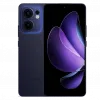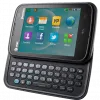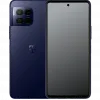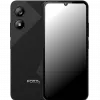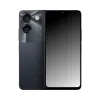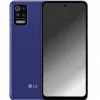GSM (Global System for Mobile Communications, originally Groupe Spécial Mobile), is a standard set developed by the European Telecommunications Standards Institute (ETSI) to describe technologies for second generation (or "2G") digital cellular networks. Developed as a replacement for first generation analog cellular networks, the GSM standard originally described a digital, circuit switched network optimized for full duplex voice telephony. The standard was expanded over time to include first circuit switched data transport, then packet data transport via GPRS. Packet data transmission speeds were later increased via EDGE. The GSM standard is succeeded by the third generation (or "3G") UMTS standard developed by the 3GPP. GSM networks will evolve further as they begin to incorporate fourth generation (or "4G") LTE Advanced standards. "GSM" is a trademark owned by the GSM Association.
The GSM Association estimates that technologies defined in the GSM standard serve 80% of the global mobile market, encompassing more than 1.5 billion people across more than 212 countries and territories, making GSM the most ubiquitous of the many standards for cellular networks.
Early European analog cellular networks employed an uncoordinated mix of technologies and protocols that varied from country to country, preventing interoperability of subscriber equipment and increasing complexity for equipment manufacturers who had to contend with varying standards from a fragmented market. The work to develop a European standard for digital cellular voice telephony began in 1982 when the European Conference of Postal and Telecommunications Administrations (CEPT) created the Groupe Spécial Mobile committee and provided a permanent group of technical support personnel, based in Paris. In 1987, 15 representatives from 13 European countries signed a memorandum of understanding to develop and deploy a common cellular telephone system across Europe. The foresight of deciding to develop a continental standard paid off, eventually resulting in a unified, open, standard-based network larger than that in the United States.
France and Germany signed a joint development agreement in 1984 and were joined by Italy and the UK in 1986. In 1986 the European Commission proposed to reserve the 900 MHz spectrum band for GSM. By 1987, basic parameters of the GSM standard had been agreed upon and 15 representatives from 13 European nations signed a memorandum of understanding in Copenhagen, committing to deploy GSM. In 1989, the Groupe Spécial Mobile committee was transferred from CEPT to the European Telecommunications Standards Institute (ETSI).
Phase I of the GSM specifications were published in 1990. Finnish mobile network operator Radiolinja completed the first GSM telephone call in July, 1991. 1992, the first short messaging service (SMS or "text message") message was sent and Vodafone UK and Telecom Finland signed the first international roaming agreement. Work had begun in 1991 to expand the GSM standard to the 1800 MHz frequency band and the first 1800 MHz network became operational in the UK in 1993. Also in 1993, Telecom Australia became the first network operator to deploy a GSM network outside of Europe and the first practical hand-held GSM mobile phone became available. In 1995, fax, data and SMS messaging services became commercially operational, the first 1900 MHz GSM network in the world became operational in the United States and GSM subscribers worldwide exceeded 10 million. In this same year, the GSM Association was formed. Pre-paid GSM SIM cards were launched in 1996 and worldwide GSM subscribers passed 100 million in 1998.
In 2000, the first commercial GPRS services were launched and the first GPRS compatible handsets became available for sale. In 2001 the first UMTS (W-CDMA) network was launched and worldwide GSM subscribers exceeded 500 million. In 2002 the first multimedia messaging services (MMS) were introduced and the first GSM network in the 800 MHz frequency band became operational. EDGE services first became operational in a network in 2003 and the number of worldwide GSM subscribers exceeded 1 billion in 2004.
By 2005, GSM networks accounted for more than 75% of the worldwide cellular network market, serving 1.5 billion subscribers. In 2005, the first HSDPA capable network also became operational. The first HSUPA network was launched in 2007 and worldwide GSM subscribers exceeded two billion in 2008.
The GSM Association estimates that technologies defined in the GSM standard serve 80% of the global mobile market, encompassing more than 1.5 billion people across more than 212 countries and territories, making GSM the most ubiquitous of the many standards for cellular networks.
GSM is a cellular network, which means that mobile phones connect to it by searching for cells in the immediate vicinity. There are five different cell sizes in a GSM network—macro, micro, pico, femto and umbrella cells. The coverage area of each cell varies according to the implementation environment. Macro cells can be regarded as cells where the base station antenna is installed on a mast or a building above average roof top level. Micro cells are cells whose antenna height is under average roof top level; they are typically used in urban areas. Picocells are small cells whose coverage diameter is a few dozen metres; they are mainly used indoors. Femtocells are cells designed for use in residential or small business environments and connect to the service provider’s network via a broadband internet connection. Umbrella cells are used to cover shadowed regions of smaller cells and fill in gaps in coverage between those cells.
Cell horizontal radius varies depending on antenna height, antenna gain and propagation conditions from a couple of hundred meters to several tens of kilometres. The longest distance the GSM specification supports in practical use is 35 kilometres (22 mi). There are also several implementations of the concept of an extended cell, where the cell radius could be double or even more, depending on the antenna system, the type of terrain and the timing advance.
Indoor coverage is also supported by GSM and may be achieved by using an indoor picocell base station, or an indoor repeater with distributed indoor antennas fed through power splitters, to deliver the radio signals from an antenna outdoors to the separate indoor distributed antenna system. These are typically deployed when a lot of call capacity is needed indoors; for example, in shopping centers or airports. However, this is not a prerequisite, since indoor coverage is also provided by in-building penetration of the radio signals from any nearby cell.
The modulation used in GSM is Gaussian minimum-shift keying (GMSK), a kind of continuous-phase frequency shift keying. In GMSK, the signal to be modulated onto the carrier is first smoothed with a Gaussian low-pass filter prior to being fed to a frequency modulator, which greatly reduces the interference to neighboring channels (adjacent-channel interference).
GSM carrier frequencies
GSM networks operate in a number of different carrier frequency ranges (separated into GSM frequency ranges for 2G and UMTS frequency bands for 3G), with most 2G GSM networks operating in the 900 MHz or 1800 MHz bands. Where these bands were already allocated, the 850 MHz and 1900 MHz bands were used instead (for example in Canada and the United States). In rare cases the 400 and 450 MHz frequency bands are assigned in some countries because they were previously used for first-generation systems.
Most 3G networks in Europe operate in the 2100 MHz frequency band.
Regardless of the frequency selected by an operator, it is divided into timeslots for individual phones to use. This allows eight full-rate or sixteen half-rate speech channels per radio frequency. These eight radio timeslots (or eight burst periods) are grouped into a TDMA frame. Half rate channels use alternate frames in the same timeslot. The channel data rate for all 8 channels is 270.833 kbit/s, and the frame duration is 4.615 ms.
The transmission power in the handset is limited to a maximum of 2 watts in GSM850/900 and 1 watt in GSM1800/1900.
